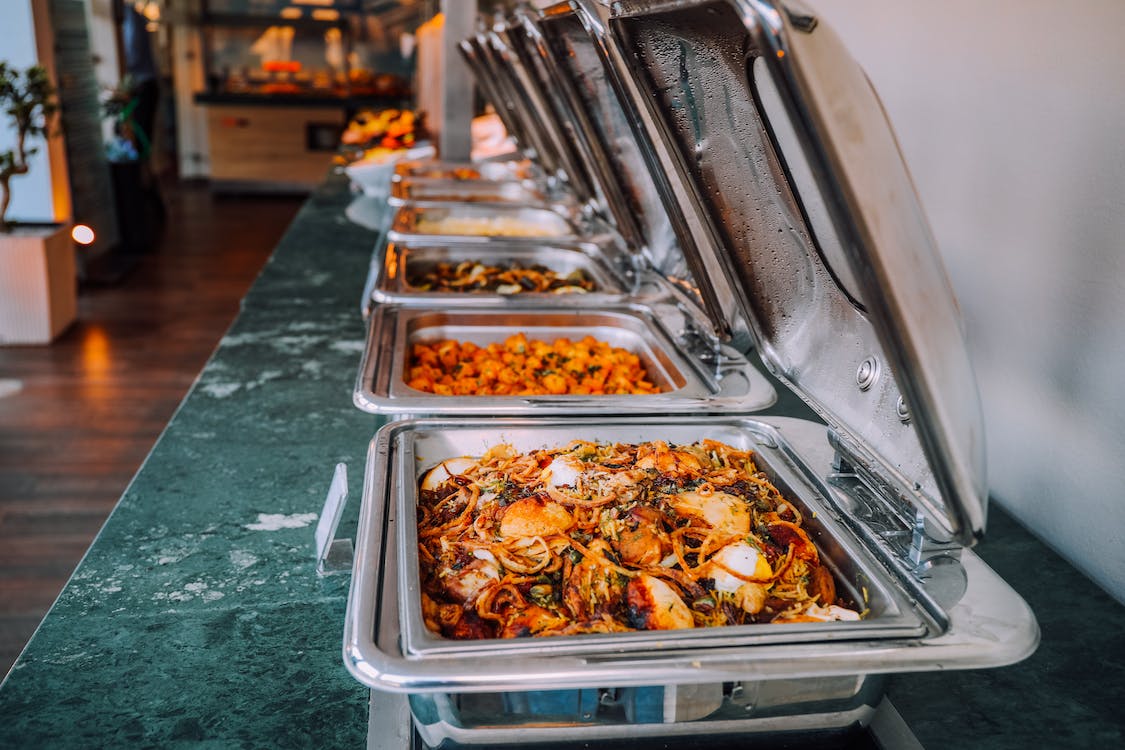Buffet table service is a popular and flexible method of presenting food and beverages that has captivated the dining industry. It is a popular choice in numerous established and respected restaurants. More so, this type of table service is known for its ease of management and operation.
Whether it’s a grand banquet or a casual gathering, the buffet style of table service provides an interactive and enjoyable way to savor a meal. But what exactly is buffet table service, and how can we set it up efficiently and successfully for celebrations or events?
What is Buffet type?
Buffet table service, commonly referred to as an “Eat All You Can”, gained widespread popularity as a preferred option for self-service dining. It offers customers the freedom to serve themselves and select the desired quantity of food, all for a fixed price. This style of dining has proven to be particularly practical when catering to large groups, as it allows for efficient and streamlined service.
Buffet service is particularly suitable for events with limited budgets or a relaxed atmosphere. One of the key benefits is that guests can visually inspect the available food options before making their selections, ensuring they take only what they desire. It is important to note, however, that while buffet service excels in practicality, it may be perceived as less formal compared to traditional table service. Nevertheless, buffet service remains a popular choice for hosting large gatherings, including formal wedding receptions.
With buffet service, guests can customize their plates according to their preferences, selecting the dishes and portion sizes that suit their taste. Buffet service is a popular choice for breakfast, lunch, dinner, and special events due to its convenience, flexibility, and ability to efficiently cater to a large number of people. It is commonly found in hotels, restaurants, banquet halls, and catering establishments, providing guests with an engaging and interactive dining experience.
Preparing for a Memorable Buffet Service
Creating a Flavorful Menu
When organizing your buffet, the menu plays a vital role in its success. Keep these suggestions in mind to create a mouthwatering and diverse array of dishes. Choose foods that are easy for guests to serve and portion themselves, opting for smaller, manageable options. For appetizers and bite-sized treats, consider using toothpicks or skewers to make them convenient finger foods. One crucial aspect is to avoid overwhelming guests with excessively sweet treats or heavy alcoholic beverages. While it’s tempting to indulge in rich and decadent offerings, it’s essential to strike a balance. Take into account dietary restrictions by providing a variety of choices, such as vegetarian or gluten-free dishes. Construct a well-balanced menu with a mix of flavors and textures, including an abundance of vegetables, enticing starches, and an appropriate amount of protein.
By offering a variety of options, you empower guests to select items that align with their personal preferences and dietary requirements. This approach ensures that guests can enjoy their meals without feeling weighed down or compelled to consume items that do not suit their tastes.
Appropriate Table Lay out
Creating an ideal table layout is vital for a successful buffet, and it starts with adapting to the available space. In a small room, a recommended approach is to arrange the tables in a U shape, positioning them along the room’s edges. This configuration optimizes the utilization of space while facilitating easy navigation for guests. By providing a clear pathway, congestion is minimized, ensuring a smooth flow throughout the buffet area.
For larger areas, a long rectangle shape works well, offering ample space for multiple guests to access the buffet simultaneously. Placing the tables in a linear fashion enables guests to move from one end to the other smoothly, conveniently accessing the dishes of their choice.
When deciding on the table arrangement, it is crucial to consider traffic flow and accessibility. It is essential to leave sufficient space between tables and around the buffet area to accommodate guest movement comfortably. Avoiding blocked pathways or obstructions is important to prevent any hindrance to the flow of guests. By optimizing the layout according to the available space, a seamless dining experience can be ensured for everyone attending the buffet.
Proper Placement of Dishes
When setting up the buffet, begin by placing the most abundant or cost-effective food options at the start of the buffet line. This allows guests to serve themselves generously and reduces the risk of running out of popular choices too soon. It also sets a positive tone, enticing guests with a wide variety of options right from the beginning.
Arrange the serving dishes ahead of time to ensure sufficient space for all items. Group similar foods together, such as salads, vegetables, and main dishes, for a logical layout. Leave open spaces for guests to place additional food they may bring. Ensure that all food items are easily reachable to prevent spills and accidents.
Start with cold dishes like salads and veggie trays, placing them close to the front to allow guests to quickly move through the buffet line. This placement encourages guests to start their meal with refreshing options.
Maintaining Warmth with Proper Equipment
To ensure that your hot dishes remain warm and ready to be enjoyed by your guests, here are some important steps to follow.
- Utilize warming trays, crock pots, and chafing dishes as effective tools for maintaining the temperature of hot food items.
- Place the hot dishes on these devices to keep them heated throughout the event. Ensure convenient access to electrical outlets for easy and reliable power supply to the heating appliances.
- When setting up the chafing dishes, position them safely away from walls and other flammable objects to minimize the risk of accidents.
- Place the chafing dishes on heat-proof surfaces, such as sturdy tables or countertops, to ensure safety.
- Pre-fill the water pans of the chafing dishes a few days in advance to help maintain a consistent temperature in the food.
- Monitor the water level periodically during the event and add more if necessary.
- Make sure to have an ample supply of chafing dish burner cans to provide the necessary heat source throughout the entire meal, keeping the food warm from start to finish.
Streamlining Cleanup
Simplify cleanup by using crock pot liners or lining the dishes with foil. Consider the need for lids and provide a designated area for guests to place them while serving themselves. This helps keep the buffet area organized and ensures that guests can easily access the lids when needed.
Conclusion:
Buffets have a significant and wide-ranging impact, offering numerous benefits. The array of food options allows guests to customize their meals based on their dietary preferences, ensuring satisfaction for all attendees without plagiarism. By fostering social interaction and a relaxed atmosphere, buffets create a welcoming environment where guests can freely mingle and converse while enjoying their food.
The flexibility in portion sizes empowers individuals to control their servings, granting them the freedom to indulge in their favorite dishes. Moreover, the self-service nature of buffets saves time and increases efficiency by eliminating the need for individual meal servings. With their convenience, diverse choices, and enjoyable dining experience, buffets are a popular choice for various occasions, leaving a memorable impression.

